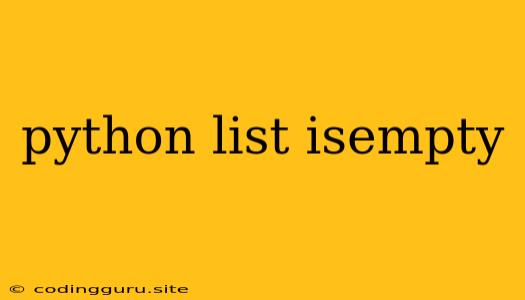How to Check if a Python List is Empty
In the world of Python programming, lists are a fundamental data structure used for storing collections of items. Often, you need to determine whether a list is empty or not. This is crucial for various reasons:
- Avoiding errors: Trying to access elements of an empty list will result in an
IndexError. Checking if a list is empty before attempting to access its elements prevents these errors. - Conditional logic: Empty lists often indicate the absence of data. Checking for emptiness allows you to execute different code paths based on whether data is present or not.
Fortunately, Python provides several ways to check if a list is empty. Let's explore the most common methods.
1. Using the len() Function
The len() function returns the number of elements in a list. You can check if the list is empty by comparing the result of len() to 0.
my_list = []
if len(my_list) == 0:
print("The list is empty.")
else:
print("The list is not empty.")
2. Using the not Operator with bool()
Python's bool() function converts a list to a boolean value. An empty list evaluates to False, while a non-empty list evaluates to True. You can use the not operator to invert this boolean value.
my_list = []
if not bool(my_list):
print("The list is empty.")
else:
print("The list is not empty.")
3. Direct Comparison with an Empty List
You can directly compare your list to an empty list using the equality operator (==).
my_list = []
if my_list == []:
print("The list is empty.")
else:
print("The list is not empty.")
4. Using the if Statement with not
You can use the if statement with the not operator to check if the list is not empty.
my_list = []
if not my_list:
print("The list is empty.")
else:
print("The list is not empty.")
Choosing the Right Method
While all the methods work, some are more readable or efficient than others.
- The
len()function is generally considered the most straightforward and efficient way to check for an empty list. - Using the
notoperator withbool()can be slightly less readable but offers a more concise approach. - Direct comparison with an empty list is also efficient, but it might be less clear in terms of readability.
- The
ifstatement withnotis the simplest and most readable, but might be slightly less efficient.
Ultimately, the best method depends on your personal preferences and the specific context of your code.
Example Scenarios
Here are a few examples of how you might use these methods in your Python code:
- Reading user input: You could use an
ifstatement withnotto check if a user has entered any input. - Data processing: You might want to check if a list returned from a function is empty before performing any further calculations.
- Error handling: You could use
len()to check if a list contains any elements before attempting to access them.
Conclusion
Checking for an empty list is a common task in Python programming. By using the methods discussed above, you can easily determine if a list is empty and ensure that your code handles different situations appropriately. Remember, understanding these techniques will help you write more robust and error-free Python code.
